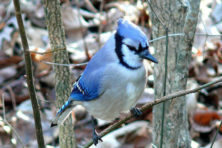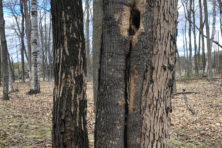Native Mimic Songbirds
- Share
- Tweet
- Pin
- Share
I can thank my parents from the bottom of my heart for developing in me, from an early age, an interest in birds and nature. For many years, after I had left home for college, for service in the U.S. Army, to teach and to graduate school, we’d have a big, annual family gathering at home on Mother’s Day. I made notes in one of my bird guides saying that during one of those gatherings our high count of bird species in the backyard was 45, with 15 of those being warblers.

A good field mark of the Gray Catbird are its rust-colored under tail coverts.
The interesting thing about this high bird concentration is that before my dad bought this large double lot, it was the neighborhood “eyesore,” the dumping ground. My dad had a magical touch with plants and put a lot of thought and planning into developing the property and building our house. A large excavating and terracing project was in progress on the Catholic Church property nearby, and he was able to get many free loads of red clay fill. With this, he gave the property a long, gentle downward slope to the west. To the south, the property was bounded by a rather steep bank where, at the top, an inviting tangle of Honeysuckle and Bridal Wreath shrubs formed a hedge.
Several Norway Spruces planted by dad and by neighbors in their adjacent yards had grown into large attractive trees. Thousands of midges in those thick spruces attracted migrating warblers, much to my enjoyment. Mourning Doves preferred the dense foliage for nesting. White-throated and White-crowned Sparrows, along with Gray-cheeked, Olive-backed and Hermit Thrushes ate the multitude of small seeds and insects that fell to the ground beneath the spruces. Next to the large conifers is where I banded most of my Lincoln Sparrows.
A large Tartarian Honeysuckle next to the northwest corner of the house was a favorite feeding spot of Ruby-throated Hummingbirds every year. Bittersweet, planted and trained to grow over a large arched trellis my dad built, was visited during many winters by Evening Grosbeaks, Cedar Waxwings, and even a Northern Mockingbird one Christmas Day. The tangle of vines and shrubs rarely failed to attract a family of House Wrens during the summer.
Because of the rather dense underbrush in the lower rock garden at the southwest corner of the lot, Gray Catbirds were sure to nest there every summer. My dad came to favor their company and always claimed that those birds seemed to like being near people. He tended the large garden early every morning before going to work and would enjoy the catbirds’ continuous conversation, its sporty black cap, blazing black eye and rusty under-tail coverts. His love for the Gray Catbird rubbed off onto me.
Catbirds lack the loud clarity of the Northern Mockingbird and Brown Thrasher but, nevertheless, are interesting singers. They do mimic other birds but only once and with single phrases sung in rapid-fire order, always interspersed with unmistakable mewing cat-calls.
What a barren uninteresting place the yard at home would have been through the years without those birds! All one has to do to practically guarantee their presence is to provide them with food, shelter, nesting sites and water. How thankful I am today for all of the planning, planting and hard work my folks did through the years.

Often when a Northern Mockingbird spends the winter at this latitude it will nest nearby the following summer.
A long time ago, when I was still working with environmental education for some of the county schools, a handsome, skittish Brown Thrasher in our backyard prompted me to have the kindergarten children I was working with make up their own names for a few of the accurately painted plastic bird models we’d been discussing. One of my favorite names came from a little girl who called an American Goldfinch a “sunbird.”
Our Brown Thrasher at home was living up to its name quite well, sweeping and “thrashing” its head from side to side in search of food and scattering debris on the ground as it did so. And if it did locate something edible, living or otherwise, it attacked it vigorously.
The head and back of the thrasher are a dazzling light cinnamon color and its whitish underparts are streaked with dark brown. What captivates us most, in addition to its song, is the fierce determined look in its flaming yellow eyes. It always looks as though it means business.
The many times we’ve heard this hearty vocalist singing in the distance it sounded as though it was just getting warmed up for real songs to follow, frequently repeating its phrases twice with clarity and power. Some of its lovely “flute-like” arias are enough to bring tears to one’s eyes.
Unlike its somewhat more trusting mimic relatives, the catbird and mockingbird, the thrasher appears to be very shy and vanishes at the slightest noise or disturbance. But if you should happen to approach its nest too closely, prepare yourself for a tongue-lashing because it becomes angry and fearless.
The first mockingbird to catch my eye in Door County did so as I drove west from Baileys Harbor toward Egg Harbor on a June day in 1965. The bird flew from an orchard tree up into a large elm alongside the road. Pure luck and duck soup to identify: the creature practically told me its name. But that was the last I saw of it that summer.
The following summer, several top birdwatcher friends from Chicago were here visiting, and on Monday, my day off work, I suggested we head toward the middle of the county to look for a mockingbird. As I think back, I remember my friend Karl Bartel asking, rather dryly, “Sure, how many?”
To make a long story short, we burned up plenty of gasoline looking for that “fictitious” creature. As a last resort, I led our two-car caravan slowly past the orchard where I had once been successful seeing the bird (along County E). When I arrived at the stop sign at County A, I had still not spotted the bird.

Rich cinnamon-colored plumage and a long tail mark the Brown Thrasher well.
Then, looking into the rearview mirror, I noticed that Karl’s car was nowhere in sight. I had been so “mockingbird conscious” that I never once noticed that he was no longer following me. I was sure he wasn’t lost, so I turned the engine off and waited.
About five minutes later, Karl came over the rise, faster than usual. He screeched up behind me, waved an arm out the window, and greeted me with one word: “Mockingbird!” They had found it. As things turned out, I was glad I had my tape recorder along because that “ham” performed beautifully for us. Its repertoire included both northern and southern birds, such as the Chuck-will’s-widow and the Tufted Titmouse. Over and over, this awesome singer imitated its relatives, several dozen species in all. What a concert!
And to make matters even better, the bird remained in its territory most of the summer and sang for many spellbound Homo sapiens during my early morning bird outings. Here, truly, was an “out-of-stater” we welcomed with open hearts. It brought great enjoyment that will live with us for a long time in the form of a taped concert.
The more I study and observe the mimics, the more I admire them. Aristocrats of song, backyard nightingales, and fearless individualists, they are quick to help a neighboring bird, easy-to-get-along with, and scrupulously clean “housekeepers.” We humans would do well, indeed, to mimic the mimics!



